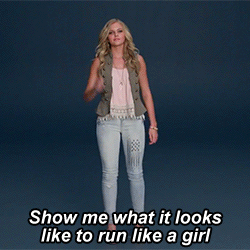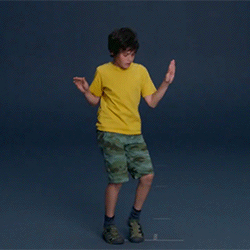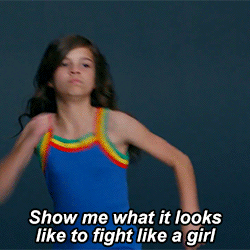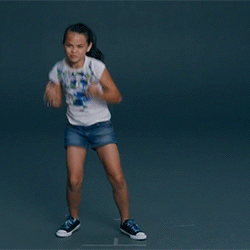
Rhetorical Analysis
For the past thirty years, Always, the feminine hygiene brand owned by Procter & Gamble, has been empowering girls globally. However, their “Like A Girl” campaign launched in 2014 and featured during the Super Bowl took it to the next level. This commercial advertisement illustrated the differences in how women, boys, and young girls perceive what it means to act “like a girl.” Growing up, young girls are constantly surrounded by pressure developing from a wide range of sources such as their peers, media, etc. Pressure is heightened during their teenage years, and this is when girls lack confidence the most. Due to this, Always decided to use their resources to broadcast this important issue rather than promoting their brand.
Why Can't Run 'Like a Girl' Also Mean Win the Race?
Interview Analysis
They first interviewed older girls and boys, asking them what completing certain activities look like as a girl. Then, they ask the same questions to young girls, around the age of ten. The outcome proves that the confidence and determination in a young ten-year-old girl eventually fades away as they grow older. By focusing on the stereotypes society has of females, Always’ “Like A Girl” commercial highlights the importance of promoting confidence within developing girls by appealing to pathos within the audience.
While most brands like Always are directing their advertisements towards women, the decision to air this commercial during the Super Bowl strategically incorporates boys of all ages into the audience. The full commercial was aired originally last year, but choosing to air 60 seconds of it during the Super Bowl broadened the audience and generated a much larger impact within society. In a way, the commercial places a sense of responsibility on boys to be aware of the impact these stereotypes have on developing girls. Interviewing both girls and boys displays both sides of the issue, showing how both older girls and boys have learned to treat the phrase “like a girl” as an insult.
One interesting part halfway through the commercial was when a young boy was asked if what he had done was insulting to his sister, in which he replied, “No! I mean yeah, insulted girls. Not my sister.” The hesitation in his response proves that he didn’t think at first about what he had done, and then he realized what his actions meant. He realized, even at a young age, that what he had done was considered insulting to girls. This was a turning point in the commercial, because it was the first time there was a question made about whether what they had done was insulting or not.
Including a reference in this interview to the young boy’s sister also makes the commercial more personal, appealing to pathos within the young boy and the audience viewing this. For those watching, they can imagine a girl in their life who they also wouldn’t want to insult. A young girl gave another convicting response when she was asked if “like a girl” was a good thing. She replies, “I actually don’t know if it’s a bad thing or a good thing. It sounds like a bad thing. It sounds like you’re trying to humiliate someone.” This ultimately proves the point that young girls aren’t completely sure yet whether or not this statement is an insult, but they believe it is when they should have no reason to. Including direct interviews of young girls is another way the commercial appeals to pathos, but also logos. Rather than just stating the statistics of young girls experiencing confidence issues, incorporating real life interviews gives the viewer an exact illustration of what is happening in our society.
Compositional Analysis
According to Pavel Zemliansky within his article, “…visual arguments usually do not contain the kind of succinct thesis statements…instead, the clues about such texts’ argumentative nature are elsewhere: in the author’s intentions, the context surrounding the photograph, in its composition, color-scheme, and so on.” This quote relates to the commercial in many ways, where the audience has to pay attention to certain strategic choices the composer makes in order to fully understand the argument.
The set for the commercial is a plain blue backdrop, with the focus being solely on those being interviewed. In several instances, the set of the commercial is shown, and the director is also shown asking the questions, making the audience feel as if they are in the room themselves. This commercial in particular stands out from many others during the Super Bowl and in general because it lacks exaggerated props and visual effects, but instead uses the interviews themselves to make a lasting impact to the audience. This visual aspect identifies with Bang’s fifth principle stating that the center of the page is the most effective center of attention, or “point of greatest attraction.” Rather than being distracted by dramatic effects or props, the viewer stays focused on the message being presented.
Furthermore, the “Like A Girl” commercial uses music to add to the emotional effect and growth of the commercial. During the interviews with older girls and boys, the music is monotone and mellow piano tones, but as soon as the young girls begin answering the interview questions, an orchestra plays into the background. The style of music makes you instantly feel more sympathy and regard towards the vulnerability of the young girls and their responses. The first question given to the young girls by the director is in the same tone as it was given to the older individuals, however, as the interview with the young girls continues, the director shifts her tone into giving each command with more conviction. This slight shift in delivery makes a huge impact in the way the young girls perceive the action. “Fight like a girl” and “run like a girl” are spoken to them with conviction, in such a way that motivates and inspires them to try hard. Whether or not this was intentional within the development of the commercial, it creates a noticeable difference in the way the young girls perceive the command.
Always commissioned a study of the ad and says that 76 percent of young women ages 16 to 24 said they no longer saw “like a girl” as an insult.
Further, two out of three men who watched it said they would think twice before using the phrase as an insult. This data alone proves already how much of an impact this commercial is having on our society.
"Let's make 'Like a girl' mean amazing things"
The end of the full-length commercial consists of older girls giving their advice to young girls struggling with confidence. The purpose of the conclusion is to develop a way to fix the issue presented. A statement is presented and says: “A girl’s confidence plummets during puberty. Always wants to change that.” This statement boldly states the issue, and that this brand wants to change it. Offering advice to young girls is the first step presented in making changes towards the direction our society is going in.
Overall, the way this advertisement has been presented makes a bold statement in a simple way. Part of why people identify so well with commercials like this one is because it involves real people and current issues. For once, a commercial isn’t throwing out statistics and brand promotion, and this is refreshing. The “Like A Girl” campaign is just the beginning of a new type of advertisement in which we focus more on improving our society and the way we treat one another. Although this commercial may not have generated more interest in their product, the advertisement made Always stand apart in a positive way.








